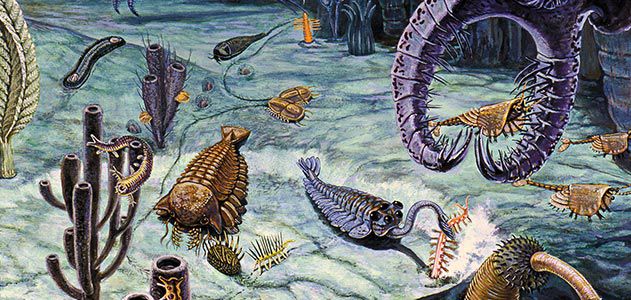If you could fly backwards into the past at the rate of one year per second, it would take you about half an hour to reach the time of Christ, and a little over three weeks to get back to the beginnings of human life. But it would take you twenty years to reach the dawn of the Cambrian period. It was, in other words, an extremely long time ago, and the world was a very different place.
要是你能以每秒鐘一年的速度飛回到過去,那么你要花大約半個小時才能抵達耶穌的年代,花三個多星期才能返回人類起始的時刻。但是,你要花上20年的時間才能抵達寒武紀初期。換句話說,那是在很久很久以前,當時的世界還是另一個模樣。
For one thing, 500-million-plus years ago when the Burgess Shale was formed it wasn't at the top of a mountain but at the foot of one. Specifically it was a shallow ocean basin at the bottom of a steep cliff. The seas of that time teemed with life, but normally the animals left no record because they were soft-bodied and decayed upon dying. But at Burgess the cliff collapsed, and the creatures below, entombed in a mudslide, were pressed like flowers in a book, their features preserved in wondrous detail.
首先,當5億多年前布爾吉斯頁巖形成的時候,它不在山頂上,而是在山腳下。具體來說。它是在一座陡峭懸崖腳下的淺海里。那個時候的大海里充滿了生命,但在通常情況下動物沒有留下記錄,因為它們是軟體動物,一死就腐爛了。然而,在布爾吉斯,懸崖崩塌下來,下面的生物被泥石流所埋葬,像壓在書里的花朵那樣被緊緊壓住,從而極其詳盡地保留了它們的特征。

In annual summer trips from 1910 to 1925 (by which time he was seventy-five years old), Walcott excavated tens of thousands of specimens (Gould says 80,000; the normally unimpeachable fact checkers of National Georgraphic say 60,000), which he brought back to Washington for further study. In both sheer numbers and diversity the collection was unparalleled. Some of the Burgess fossils had shells; many others did not. Some were sighted, others blind. The variety was enormous, consisting of 140 species by one count.
從1910-1925年(那時候沃爾科特已經75歲),沃爾科特每年夏天都要出門考察,發掘了成千上萬件標本(古爾德說是8萬件,《國家地理雜志》那些通常可靠的事實核對人員說是6萬件),將其帶回華盛頓作進一步研究。無論在數量上還是在品種上,他的收藏品都是無與倫比的。有的布爾吉斯化石帶殼,許多不帶。品種是極其繁多的,有人統計是l40種。












